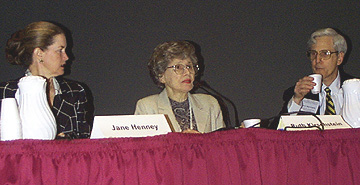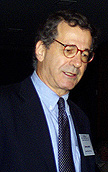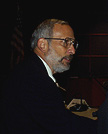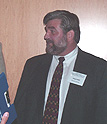
| T H E N I H C A T A L Y S T | S E P T E M B E R – O C T O B E R 2000 |
|
|
|
WHERE TO DRAW THE BOTTOM LINE:FINANCIAL CONFLICT OF INTEREST IN CLINICAL RESEARCH |
text and photos |
 |
|
Steering
the Course: (left
to right) FDA Commissioner Jane Henney; Ruth Kirschstein, NIH principal
deputy director; and Stuart Nightingale, an HHS senior medical advisor
and chair of the conference planning committee, set the stage for a two-day
exploration of how best to disarm the threat of what Kirschstein termed
a "collision" of financial interests and investigator objectivity.
|
One year after the death of 18-year-old Jesse Gelsinger in a University of Pennsylvania gene therapy trial, the research community and its federal overseers continue to grapple with strategies to ensure the scientific integrity of clinical trials, the safety of patients enrolled in them, and the objectivity of investigators conducting them.
These essential components of clinical research—scientific integrity, patient safety, and investigator objectivity—may be compromised when researchers or institutions conducting a trial, or members of the review board that approves it, are financially invested in the product under study or its sponsor, participants agreed at an overflow conference here on "Human Subject Protection and Financial Conflict of Interest."
The conference was convened by HHS and its agencies (FDA, NIH, and CDC) to tackle the issue of real and perceived investigator bias in a research environment increasingly invested in "breakthrough" results and the drive for efficient technology transfer, as mandated in the Bayh-Dole Act.
The blurring lines between study sponsor and investigator and the ethical problems this creates—brought into sharp relief by the circumstances of the Penn trial but not unique to it—were the main subject of the conference. The spotlight was cast on the potential threats to study integrity wrought by the growing involvement of clinical investigators and research institutions in the companies sponsoring trials they are supervising.
|
No Two Ways About It Where do you draw the line on conflicts of interest? "Would it pass the ‘60 Minutes’ test? If not, don’t allow it."—Abbey Meyers, National Organization for Rare Disorders. |
The central questions posed to conference participants revolved around where to draw the line between acceptable and unacceptable financial interests among the parties involved in a clinical trial and whether, when, and how much to disclose to study patients.
The answers were diverse. Many speakers believed that most financial conflicts of interest could be "managed" to eliminate the possibility of harm to either research subjects or research results. Others contended that nothing short of elimination of the financial conflict itself would do.
(Based on the conference proceedings and written responses to six questions posed in the July 3 Federal Register notice announcing the conference, HHS will produce new guidelines for the medical research community. The deadline for responses is September 30. See "Have Your Say," below.)
Setting the Stage
"Objectivity," NIH Principal Deputy Director Ruth Kirschstein said, "lies at the heart of science and must not be compromised by financial gain—or fame or the pursuit of insights," she added, noting that it is not only money that can color an investigator’s judgment, but that only money was the issue at hand this time around. She asked the assembled to "share your best practices" in the realms of disclosure of financial interest and distinguishing financial interests that do and do not compromise objectivity.
FDA Commissioner Jane Henney noted that under current FDA procedures, disclosure of an investigator’s financial interest in the product under study—or certification that there are no such interests—is required at the time of FDA review of the completed study, not at the time of application to pursue the study. But she asked whether disclosure of financial interests alone would be enough to protect patient safety. The death of Jesse Gelsinger, she observed, had "raised the question of whether financial interest had clouded clinical judgment. . . . the multiple hats of the physician/clinical investigator/sponsor [create] real and perceived conflicts of interest and must be addressed."
Zero Tolerance
 |
|
Not
eye to eye: James Benson (left) and Marcia Angell
|
The way to address conflicts of interest, according to Marcia Angell, a lecturer in social medicine at Harvard and former editor of the New England Journal of Medicine, is to prohibit them. She defined a financial conflict of interest as any financial association that could cause an investigator to prefer one outcome over another and dismissed the notion that disclosure of financial conflicts of interest in patient consent forms would in any way protect patients. "That simply passes the buck to the patient. It’s just ‘caveat emptor.’"
Angell decried "dancing on the margins of the issue . . . to accommodate something that shouldn’t exist in the first place" and pointed to Harvard’s "impenetrable pages" as an example of "mind-boggling guidelines" that miss the essential point: "Investigators with grant support from industry must have no other financial ties to that company, just like a judge on the bench deciding the merits of a case."
"In my two decades [at the NEJM]," Angell said, "it has been my impression that bias in study design and interpretation of data are far more likely in investigators with industry ties."
Moreover, she advised that:
![]() Grants from industry to institutions should come with no strings attached, as
they used to.
Grants from industry to institutions should come with no strings attached, as
they used to.
![]() Technology transfer does not require consultancy fees.
Technology transfer does not require consultancy fees.
![]() Institutions and their senior officials should limit their investment portfolio
to "rubies and racehorses."
Institutions and their senior officials should limit their investment portfolio
to "rubies and racehorses."
"This might seem radical," she added, "but it’s only because our society is so drenched in market ideology that opposition seems quixotic."
"It’s a lot more complex than that," countered James Benson, an officer of the Advanced Medical Technology Association (formerly the Health Industry Manufacturers Association). Up to two-thirds of "breakthrough" devices, he said, originate from an engineer who creates a small start-up company and has no other way of financing research but through offering scientists equity.
Speakers for the Association of American Universities and the Association of American Medical Colleges cautioned against overregulation and equating conflict of interest with scientific misconduct. The latter could be prevented with appropriate institutional safeguards.
Industry Influence
Traditional sources of financial support for medical schools have been drying up, and industry has been stepping in. According to a survey undertaken by the Massachusetts General Hospital Institute for Health Policy, director David Blumenthal said, about 25 percent of medical school facilities have research support from industry and about 8 percent have equity in companies related to their research.
 |
|
Sid
Wolfe
|
Sid Wolfe, long-time director of the Washington-based Health Research Group, a patient advocacy organization, warned of the burgeoning "for-profit human experimentation industry" with its "business model of recruiting research subjects for their paying clients, the pharmaceutical companies." These corporations, he said, have no teaching or care responsibilities and they "recruit from private practices, offering monetary incentives to private physicians with no clinical research experience who persuade their vulnerable patients to sign up." They should be abolished, Wolfe said, as should finders’ fees to physicians (typically in the range of $1,000 to $5,000 per patient).
 |
|
Thomas
Bodenheimer
|
Further cause for alarm over industry control of clinical studies was provided by Thomas Bodenheimer, clinical professor of family and community medicine at the UCSF School of Medicine and a correspondent for the NEJM. He presented data showing that published findings are nearly always favorable to the study drug when the study was funded by the drug maker and that study drugs are given more favorable write-ups when the author has financial ties to the sponsor.
He presented documented cases of faulty trial design (competing drugs given in ineffective doses or by inappropriate routes; study population substantially different from intended patient population), skewed data analysis (results reported only from those sites in a multicenter trial at which the study drug did well), suppression of publication altogether in the face of unfavorable findings, "conclusions" in abstract or summary that are not supported by the data, and the use of hired "ghosts" to write reports under an investigator’s name.
Remedies, he said, include separating sponsors from all aspects of study design, data analysis, and publishing. More funding of clinical investigators should come from NIH than from industry, he urged, and industry should funnel its budgeted clinical trial money through NIH and then walk away, leaving NIH to sponsor the trial.
Some Policies and Practices
From a professional society: Savio Woo, president of the American Society of Gene Therapy, announced that his organization had adopted the policy that its members either refrain from participation in a study sponsored by a company in which they have a financial interest or, alternatively, give up that interest.
At research institutions:
![]() At Boston Children’s Hospital, said Susan Kornetsky, director of clinical
research compliance, disclosure of financial interests accompanies research
protocols submitted to the IRB, which decides whether and how much to inform
research subjects (an IRB member with a conflict must leave the room during
the final discussion and vote); all faculty must comply with Harvard policy,
which places a ceiling on the amount of allowable financial gain; a trial may
not be supervised or conducted by the inventor of the study product; recruitment
fees and completion bonuses are prohibited; if the hospital has an equity interest,
that must be disclosed in the informed consent document; and issues of budget,
publishing rights, and data ownership must be agreed upon before protocol approval.
At Boston Children’s Hospital, said Susan Kornetsky, director of clinical
research compliance, disclosure of financial interests accompanies research
protocols submitted to the IRB, which decides whether and how much to inform
research subjects (an IRB member with a conflict must leave the room during
the final discussion and vote); all faculty must comply with Harvard policy,
which places a ceiling on the amount of allowable financial gain; a trial may
not be supervised or conducted by the inventor of the study product; recruitment
fees and completion bonuses are prohibited; if the hospital has an equity interest,
that must be disclosed in the informed consent document; and issues of budget,
publishing rights, and data ownership must be agreed upon before protocol approval.
![]() "There is no evidence that financial interests, which have become part
of the research landscape, are inherently harmful," said Julie Gottlieb,
executive director of the Office of Policy Coordination at Johns Hopkins University
School of Medicine in Baltimore, "but they require disclosure and review,
and their management is labor-intensive." Hopkins has a separate Conflict
of Interest Committee, made up of senior faculty and administrators, that meets
regularly and is advisory to the IRB. Hopkins policy requires reporting of all
financial interests, however small and whatever the nature of the research—basic
or clinical—and public disclosure in the patient consent form. Investigators
with a financial interest may not be the principal investigator, obtain informed
consent, or analyze data. Divestiture of financial interests and bottom-line
rejection of the protocol are also possibilities.
"There is no evidence that financial interests, which have become part
of the research landscape, are inherently harmful," said Julie Gottlieb,
executive director of the Office of Policy Coordination at Johns Hopkins University
School of Medicine in Baltimore, "but they require disclosure and review,
and their management is labor-intensive." Hopkins has a separate Conflict
of Interest Committee, made up of senior faculty and administrators, that meets
regularly and is advisory to the IRB. Hopkins policy requires reporting of all
financial interests, however small and whatever the nature of the research—basic
or clinical—and public disclosure in the patient consent form. Investigators
with a financial interest may not be the principal investigator, obtain informed
consent, or analyze data. Divestiture of financial interests and bottom-line
rejection of the protocol are also possibilities.
 |
|
Greg
Koski
|
Summing Up
Greg Koski, the first director of the newly revamped HHS Office for Human Research Protections, summed up what he saw as areas of consensus:
![]() Conflict of interest in clinical research is real and is a threat to clinical
research.
Conflict of interest in clinical research is real and is a threat to clinical
research.
![]() Conflict of interest has intensified over the last two decades and has gotten
"out of control" in the last five years.
Conflict of interest has intensified over the last two decades and has gotten
"out of control" in the last five years.
![]() Those conflicts of interest that cannot be eliminated completely must be "managed,"
and institutional review boards cannot do it alone. There need to be uniform
guidelines throughout government—or, if compliance is lagging, then rules.
Those conflicts of interest that cannot be eliminated completely must be "managed,"
and institutional review boards cannot do it alone. There need to be uniform
guidelines throughout government—or, if compliance is lagging, then rules.
![]()
|
Though the conference on "Human Subject Protection and Financial Conflict of Interest" unexpectedly drew nearly 800 registrants, several speakers observed that the meeting was short on clinical investigators and patients. Federal officials expressed the hope that some of that gap would be filled by written responses to six questions posed in the July 3 Federal Register to jump-start the conference. For a conference overview, with links to the questions and other materials, visit Responses may be sent to or to Stuart Nightingale, Office of the Assistant Secretary for Planning and Evaluation, Hubert H. Humphrey Building, Room 447D, 200 Independence Ave., S.W., Washington, D.C. 20201. The deadline is
September 30. |
|
Much of the public examination of the conduct and federal oversight of the University of Pennsylvania gene therapy trial, as well as of clinical trials in general, has taken place on the NIH campus. Last December, newspapers across the country carried the details of how the Penn study was conducted, the pitfalls of adenovirus gene vectors, and the controversies over clinical trial adverse event reporting and the curtailed authority of the NIH Recombinant DNA Advisory Committee (RAC)—the substance of a heavily attended three-day meeting here of the RAC (see The NIH Catalyst, January-February 2000). Subsequent meetings of the RAC and the Advisory Committee to the NIH Director (ACD) examined the boundaries of NIH and RAC oversight of clinical gene transfer research. An ACD working group convened last year by then-NIH director Harold Varmus issued a preliminary report in July suggesting changes in protocol submission and review procedures that would ensure RAC input into novel gene therapy protocols before they are presented to authorizing bodies such as the Food and Drug Administration. Although investigators would not be required to comply with any RAC requests, such as more preclinical work or protocol changes, they would be required to respond publicly. The overall effect of the ACD working group proposals would be, first, to ensure that no patient is enrolled in a gene transfer study that the RAC has not reviewed and, second, to make it more likely that RAC advice is followed. A majority of the working group, as well as the RAC itself, also opted to modify RAC requirements for the reporting of serious adverse events that occur in gene therapy trials to be more in line with those of the FDA, which requires immediate notification only of those serious adverse events that are both unexpected and related to the experimental therapy. A minority of the working group, however, urged that all serious adverse events be reported as they occur, and that a central body of experts, with both FDA and RAC presence, be established to receive and interpret these reports. NIH Principal Deputy Director Ruth Kirschstein will act on the final ACD report. Meanwhile, the NIH
Intramural Research Program has crafted interim guidelines regarding reporting
adverse events for intramural investigators involved in any and all
clinical research. The details of these guidelines are under discussion,
but the current requirement is expedited reporting to the IRB of all serious
adverse events except those anticipated in the IRB-approved research protocol.
|